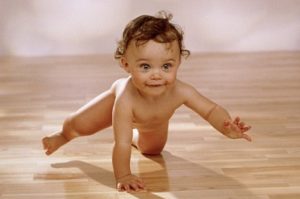
What is DNS?
In short, DNS is a treatment, exercise and rehabilitation method that reprograms the brain to restore posture, stability and movement throughout the body. The DNS approach is so groundbreaking and has such a powerful influence on improving movement that it has been integrated into the exercise and rehabilitation programs of olympic and professional level athletes.
DNS, or Dynamic Neuromuscular Stabilization, is a relatively new, advanced method of assessing and treating conditions of the muscles, joints and nervous system. The major premise of DNS is poor posture, faulty movement, and improper joint stabilization is the source of most painful and degenerative conditions of the musculoskeletal system.
DNS Rationale

In the DNS approach, an individual’s posture and movements are compared to that of an ideally developed child.
During the first few years of life, the central nervous system (CNS) is developing a child’s movement program. In 13 short months, infants progress through the developmental movement “milestones.” They go from lying helplessly on their back to rolling over, crawling, sitting upright and eventually walking.
This programming of the CNS develops stable, properly aligned joints, ideal posture, and flawless movements that are meant to last a lifetime.
Unfortunately, the injuries and pain one accumulates throughout life causes changes in the CNS which alters the movement program. Movement compensations develop to protect what hurts. Compensations are protective in the short term, but at the same time they are destructive by creating abnormal posture, unstable joints, and strained muscles.
When compensations persist long-term, unstable joints and strained tissues wear down over time leading to chronic pain and degenerative conditions, such as arthritis, tendinitis, bursitis, disc bulging, herniation, degeneration, and so on.
DNS Assessment, Treatment and Exercises
Through assessment and testing, DNS practitioners are able to find the source of pain by identifying where incorrect movements and improper joint stabilization are taking place.
Once these areas are identified, the patient is placed in developmental positions that will have the most profound influence on improving their posture, stability and movement. During treatment, the DNS practitioner gently contacts various parts of the body to create a sensory input into the CNS to “reboot” the movement program. This process often requires active participation of the patient to further enhance the reprogramming process.

Dr. Ryan Hamm being treated at a DNS course in a modified 3 month position (left) and a 7 month side position (right)
to improve the stability of the neck, shoulders and core at the same time.
DNS exercises are a vital part of the treatment program. They are performed in developmental positions, the same milestone positions in which we originally learned to move and stabilize our body.
The exercises are dynamic and retrain the neuromuscular connections to reinforce the new patterns of movement and joint stabilization, hence the creation of Dynamic Neuromuscular Stabilization.
By restoring posture, stability and movement back to the way it was originally programmed, patients are able to reduce or even stop chronic pain and the progression of degenerative conditions.
For more information about DNS, go to rehabps.com
Dr. Ryan Hamm is a chiropractor in Arlington Heights, IL and has been treating disorders of the spine and extremities for over 30 years. He specializes in identifying and correcting posture and movement dysfunctions that contribute to painful conditions of the musculoskeletal system. Dr. Hamm has an Advanced Certification in Chiropractic Biophysics (CBP) Technique and he is a certified Dynamic Neuromuscular Stabilization (DNS) practitioner and a certified DNS Exercise Trainer.




